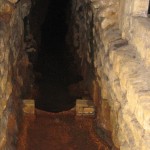The Great Drain is a water overflow system the Romans built to carry water a half a mile from the hot spring that feeds the Roman Bath in the city of Bath to the river Avon.
 It has been working since then with few interruptions during periods of abandonment. It works so consistently and effectively it hasn’t even been fully explored despite being man-sized for much of the way.
It has been working since then with few interruptions during periods of abandonment. It works so consistently and effectively it hasn’t even been fully explored despite being man-sized for much of the way.
Now thanks to a crappy extension built when the city expanded past the original walls long after the Romans left, engineers are going in for a full examination of the Great Drain and its various more modern attachments. The extension is backed up, leaving Bath in danger of flooding.
The Roman structure has easily outlasted the work of more modern engineers. A final section dating from the Sixties collapsed two years ago and had to be rebuilt.
Miles Barnes, of Bath council, said: “The Roman engineers really knew what they were doing. Most of the drain is in absolutely tip-top condition and still doing the job it was designed for.”
A large part of that is how simple the structure is. It doesn’t have any pumps or mechanisms or moving parts. It’s just solidly built tunnels and gravity that have allowed it to carry a million liters of hot water a day for 2000 years.
People are expecting to find more than great engineering down there.
When the site of the Roman Baths was originally excavated in the late 19th century, finds made in the Great Drain included 33 carved cameo gemstones and a mysterious tin mask.
Mr Barnes said: “Gems were as rare and precious then as they are now. We don’t know whether they were put in the sacred spring as an offering or just dropped by accident.”
The hot spring was sacred to the Celts, and the Romans sort of folded in the Celtic Sulis with their Minerva so there may be all kinds of votive offerings in the drain. There could also be all kinds of random stuff that fell down their over the millennia.
Even if they find no sparkly things, though, just getting a chance to fully explore the structure is a great thing. The original wooden planks that lined the drain are still there in many places. Plus, on a more practical city planning note, it’ll be helpful going forward to finally have a complete survey of the drain that keeps Bath from drowning itself.